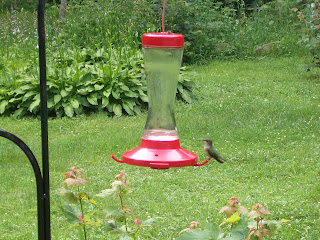
I have often thought about writing a wildlife book for children, and the chapter on the wild turkey would begin, “Do you know where the turkeys sleep? High in the treetops, standing on their feet!” For several years I followed a flock of turkeys, hiking along their trails through the woods every day, watching them come and go, mate and return with babies, and catching them asleep very early in the morning. They actually “roost” on branches high up in the trees, usually in a line along the edge of a ridge. Flying a short distance from the ridge to the top of a tree is an easy “lift” for a turkey - they generally do not fly far distances, or get very high off the ground. They stand, with their big claw feet wrapped on a good size branch, fluff out their feathers, tuck in their head, and stay that way until dawn. The descent in the morning is an easy “swoop” down out of the trees to land at the bottom of the hillside.
Beautiful, big and proud, we have all seen this bird, the wild turkey (Meleagris gallopavo) which is found in almost every area of the world. Many of us have seen huge flocks of turkeys - 30 or more at a time, but have you ever noticed just one? It repeatedly returns to the same area, or trail, never with any other turkeys, or if it happens on a flock, it will stay on the outskirts of the group, because if it ventures in the other hens chase it away. It becomes a loner, not chosen to be part of the flock, and lives out a solitary life in the wild.
In late summer, hens with their broods are emerging from the sheltering underbrush and low-lying areas around riverbeds and swamps where they have been nesting and raising their young since spring. They will join up with other hens and chicks to form large flocks (can be up to 100 turkeys in a flock). So you will see them roaming hillsides, spread out in many black dots across a wide open field, pecking along the side of the road, and coming into yards to check out birdfeeders. You might also catch a glimpse of a long line of young turkeys marching behind their mothers.
Eventually by late fall, the large flocks have separated into much smaller groups, with one or two toms to 6 or 8 hens, in preparation for the spring mating season. The “pecking order” or choosing does not appear totally random, as I’ve watched toms fight over hens and have actually seen hens switch from one group to another during a fight between the males, and switch back again, after one of the toms apparently “won”. There is no blood shed, or killing when the toms face off, they just do a lot of puffing, strutting and fluffing, and of course gobbling. Once the flock has regrouped, there usually remains a turkey or two not chosen, and it is not chosen for the simple, basic rule of the wild - survival of the fittest - the sick and weak are not wanted in the newly formed, smaller flocks. The one left behind is usually injured, old, or a young turkey not fully developed.
For several years we had “the lone turkey” in our yard, she was very old, it was apparent by her large hanging snood - the flap of skin that hangs over the turkey's beak and her wattle - the flap of skin under the turkey's chin, which turns bright red when the turkey is upset or during courtship. She had a very blue and bumpy face and neck marked with scratches and scars (we use to watch her through our binoculars), her feathers were pretty ragged and she limped – but could still fly high in a second if something startled her. She would sit under our bird feeding table during snowstorms, all hunched up, and just look so forlorn and miserable – she looked like she was wishing for greener pastures. She became use to our comings and goings and would never go very far from the yard. We’d see her sleeping in the high trees at the edge of our property, and she would be the first one in after I put out cracked corn and filled all the feeders. She had a very wise and calm presence, as if she had all the time in the world to sit out in the sun. She was our loner for several years, our guest that we called “old turkey-girl”, but sadly, last year she never returned, and we like to picture her having a gobbling good time in greener pastures.
"The Lone Turkey", previously published in
The New Marlborough 5 Village News,
February, 2007
"Turkey Tracks" ©Jan Boults Photography




























